Top 15 Desert Plants for 2025: Perfect Picks for Vibrant Landscapes
- May 13, 2024
- 0 comment
Explore the Top 15 Desert Plants for 2025! Perfect for vibrant, sustainable landscapes in arid environments. Discover your ideal garden today. As we embrace 2025, the allure of resilient and low-maintenance gardening continues to grow, making desert plants increasingly popular among garden enthusiasts and landscape designers alike.

Our list of the top 15 desert plants offers a range of species that not only thrive in arid conditions but also bring a burst of life and color to any dry landscape. From the stunning floral displays to the striking foliage, these plants are your perfect picks for creating a vibrant, enduring garden.
List of Top 15 Desert Plants for 2025
- Blue Agave (Agave tequilana)
- Joshua Tree (Yucca brevifolia)
- Red Yucca (Hesperaloe parviflora)
- Ocotillo (Fouquieria splendens)
- Saguaro Cactus (Carnegiea gigantea)
- Mexican Thread Grass (Nassella tenuissima)
- Prickly Pear Cactus (Opuntia)
- Desert Marigold (Baileya multiradiata)
- Creosote Bush (Larrea tridentata)
- Palo Verde (Parkinsonia)
- Cholla Cactus (Cylindropuntia)
- Brittlebush (Encelia farinosa)
- Beargrass (Nolina microcarpa)
- Soap Tree Yucca (Yucca elata)
- Golden Barrel Cactus (Echinocactus grusonii)
What Defines a Desert Plant?

Desert plants are nature’s answer to extreme drought and intense sunlight. Characterized by features like thick, waxy leaves, deep root systems, and reduced foliage, these plants are built to conserve water and maximize efficiency. Integrating these plants into your landscape not only ensures a lower water bill but also brings a touch of the wild, rugged beauty of the desert to your home.
Benefits of Desert Plants in Landscaping
Utilizing desert plants in landscaping offers several advantages:
- Water Efficiency: These plants require minimal irrigation, making them ideal for drought-prone areas.
- Low Maintenance: Adapted to harsh environments, desert plants typically need less care than their lush counterparts.
- Aesthetic Appeal: With their unique forms and textures, desert plants add architectural interest to any garden.
- Environmental Impact: By choosing plants suited to the local climate, gardeners can reduce their ecological footprint, promoting biodiversity.
The Top 15 Desert Plants for 2025
1. Blue Agave (Agave tequilana)
Predominantly known for its role in producing tequila, the Blue Agave is a robust plant that forms a large rosette of thick, spear-like leaves. Its distinctive blue-green color provides a cooling effect in a desert garden. This plant is extremely drought-tolerant and grows best in environments that mimic its native Mexican highlands.
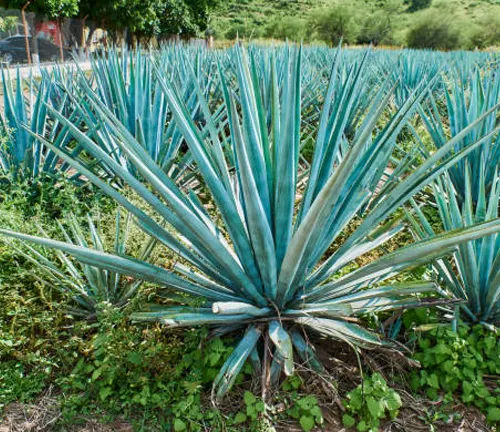
- Sunlight Requirements: Needs direct, full sun to thrive.
- Watering Needs: Water minimally; prone to root rot if overwatered.
- Soil Type: Prefers sandy, rocky, well-draining soil.
- Temperature Tolerance: Can handle mild frost but should be protected from severe cold.
- Landscape Uses: Excellent for adding structure and focus in drought-resistant gardens.
2. Joshua Tree (Yucca brevifolia)
The Joshua Tree is symbolic of the American Southwest. Its distinct appearance, with twisted branches and spiky leaves, makes it an intriguing focal point in any landscape. Adapted to the harsh Mojave Desert, it survives on minimal moisture and thrives in nutrient-poor soils.
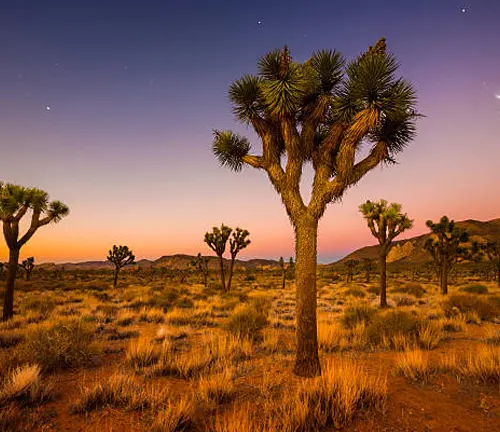
- Sunlight Requirements: Best in full sun.
- Watering Needs: Infrequent watering; too much moisture can lead to root decay.
- Soil Type: Prefers coarse, well-drained soils.
- Temperature Tolerance: Resistant to fluctuations from heat to mild frosts.
- Landscape Uses: Ideal for creating a striking silhouette in large desert gardens or open spaces.
3. Red Yucca (Hesperaloe parviflora)
The Red Yucca’s long, narrow leaves and towering flower spikes make it a garden favorite. Its flowers, ranging in color from red to pink, bloom from early summer to fall, providing long-lasting visual interest. This plant is not just tough but also versatile, adapting to various soil types while requiring little care.
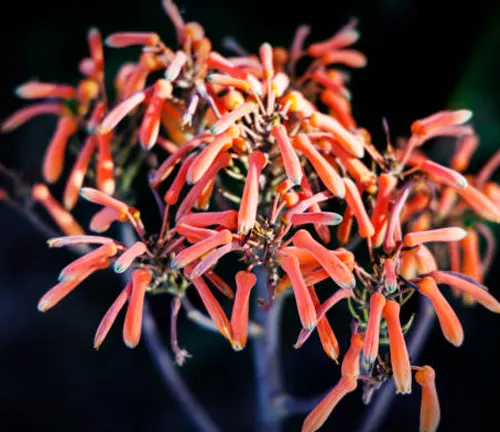
- Sunlight Requirements: Full sun enhances flowering.
- Watering Needs: Drought-resistant; occasional deep watering is sufficient.
- Soil Type: Versatile; thrives in well-drained soils.
- Temperature Tolerance: Cold-hardy; benefits from winter mulch in colder zones.
- Landscape Uses: Perfect for adding vertical elements to a garden or as a perennial border in xeriscapes.
4. Ocotillo (Fouquieria splendens)
Ocotillo is remarkable for its adaptive growth pattern; long, wand-like stems can leaf out after rain, creating a lush appearance, and revert to a dormant state during droughts. It blooms with vivid red flowers that attract hummingbirds and native pollinators, adding both beauty and ecological value to the desert garden.
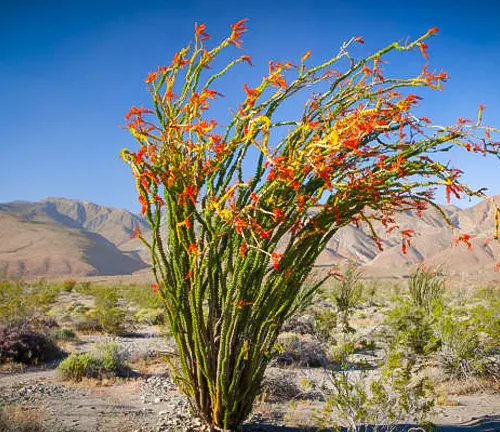
- Sunlight Requirements: Requires full, unfiltered sunlight.
- Watering Needs: Minimal; occasional deep watering during prolonged dry spells.
- Soil Type: Prefers sandy, rocky soils with excellent drainage.
- Temperature Tolerance: Moderately frost-resistant but benefits from protective measures in colder climates.
- Landscape Uses: Effective as a natural screen or barrier; also works well as an accent plant in rock gardens.
5. Saguaro Cactus (Carnegiea gigantea)
The Saguaro Cactus is a monumental plant native to the Sonoran Desert. It is known for its towering, tree-like form, which can reach heights of up to 40 feet. Saguaros grow slowly but can live for over 150 years, eventually sprouting arms that add to their iconic silhouette.
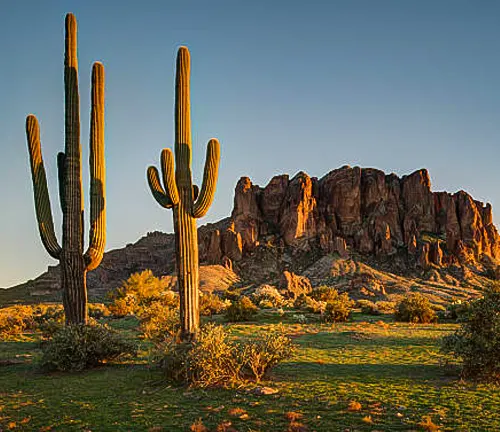
- Sunlight Requirements: Thrives in full sunlight.
- Watering Needs: Requires minimal water; natural rainfall is usually sufficient.
- Soil Type: Needs well-drained soil; does not tolerate water-logged conditions.
- Temperature Tolerance: Can withstand high heat but is vulnerable to frost. Young plants need protection from extreme cold.
- Landscape Uses: Serves as a dramatic focal point in large desert gardens and public landscapes.
6. Mexican Thread Grass (Nassella tenuissima)
Mexican Thread Grass is a fine-textured grass that sways gracefully in the breeze. It forms dense tufts of narrow, green blades that turn golden in the fall. This grass is not only visually appealing but also extremely hardy and drought-tolerant.
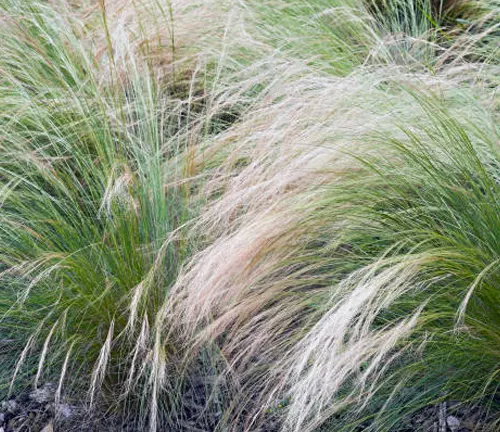
- Sunlight Requirements: Performs best in full sun but can tolerate partial shade.
- Watering Needs: Highly drought-tolerant; occasional watering during prolonged dry spells is beneficial.
- Soil Type: Adapts to a variety of soil conditions; prefers well-drained soils.
- Temperature Tolerance: Handles a range of temperatures and can survive light frosts.
- Landscape Uses: Ideal for softening landscape edges, creating a naturalistic feel, or as a ground cover in large sunny areas.
7. Prickly Pear Cactus (Opuntia)
Prickly Pear Cactus is widely recognized for its broad, flat pads and vibrant, edible fruits called “tunas.” The cactus flowers in late spring to early summer, producing yellow, red, or purple flowers, depending on the species.
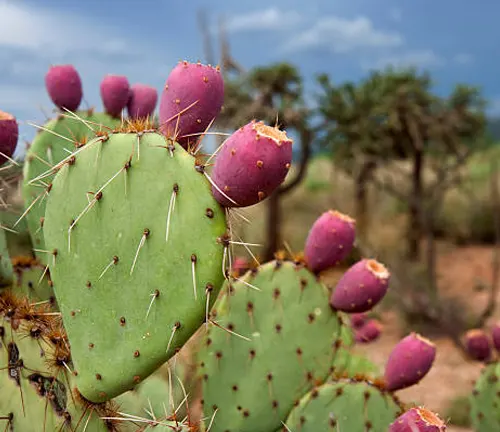
- Sunlight Requirements: Needs full sun to partial shade.
- Watering Needs: Drought-tolerant; water sparingly.
- Soil Type: Prefers sandy, well-drained soils but is quite adaptable.
- Temperature Tolerance: Generally frost-resistant, though some species may require protection in colder climates.
- Landscape Uses: Works well in rock gardens, as ground cover, or in mixed cactus plantings for varied texture and color.
8. Desert Marigold (Baileya multiradiata)
Desert Marigold is a cheerful, low-growing perennial that lights up the landscape with its bright yellow blooms. It flowers profusely in spring and sporadically through to fall, thriving in the challenging conditions of the desert.
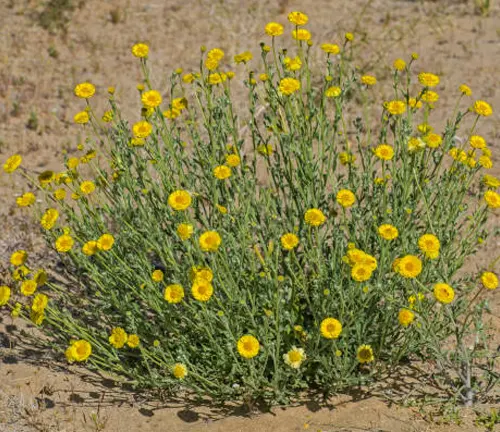
- Sunlight Requirements: Prefers full sun.
- Watering Needs: Extremely low water requirements; suited to very dry environments.
- Soil Type: Grows best in well-drained, even rocky or poor soils.
- Temperature Tolerance: Heat tolerant and can withstand moderate frosts.
- Landscape Uses: Excellent for adding splashes of color to desert gardens, along pathways, or in mass plantings for a striking display.
9. Creosote Bush (Larrea tridentata)
Creosote Bush is one of the most common and hardy desert shrubs, known for its resilience and distinctive smell after rain. It has small, waxy leaves that help it conserve moisture and yellow flowers that bloom periodically throughout the year.
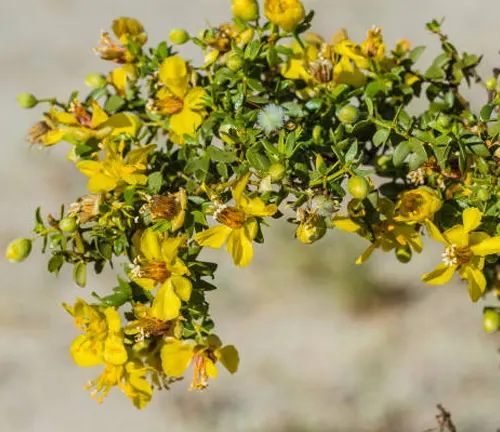
- Sunlight Requirements: Prefers full sun.
- Watering Needs: Very drought-tolerant; requires minimal supplemental watering.
- Soil Type: Thrives in well-drained soils; tolerates a variety of soil types.
- Temperature Tolerance: Heat tolerant and frost resistant.
- Landscape Uses: Ideal for use as a ground cover or a privacy screen in large desert landscapes.
10. Palo Verde (Parkinsonia)
Palo Verde, meaning “green stick” in Spanish, features green bark that photosynthesizes. It is a small to medium-sized tree with a spreading canopy that provides light, dappled shade. Spring brings a vibrant display of yellow flowers.
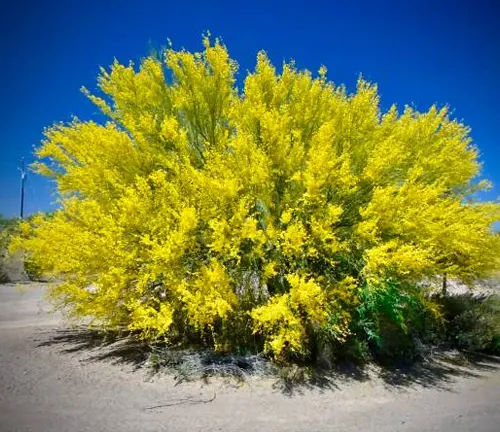
- Sunlight Requirements: Full sun to achieve best growth and flowering.
- Watering Needs: Low water requirements; should be watered deeply but infrequently.
- Soil Type: Prefers well-drained soils; adaptable to poor soils.
- Temperature Tolerance: Can handle extreme heat and moderate cold.
- Landscape Uses: Excellent as a feature tree in gardens for its aesthetic appeal and minimal shade.
11. Cholla Cactus (Cylindropuntia)
Cholla Cactus is notable for its segmented branches and striking silhouette. It produces beautiful flowers ranging from yellow to red, depending on the species. This cactus is also known for its barbed spines, which can detach easily.
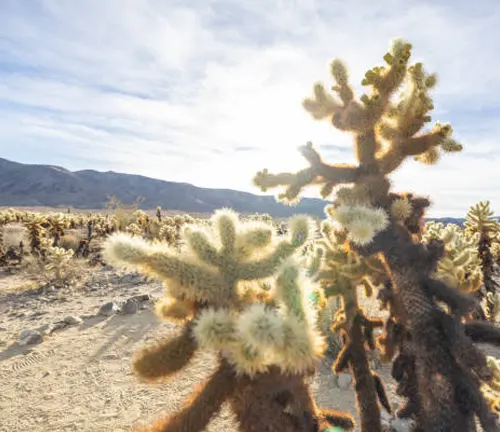
- Sunlight Requirements: Requires full sun to flourish.
- Watering Needs: Extremely drought-tolerant; occasional watering helps during extreme dry spells.
- Soil Type: Best in sandy, well-drained soils.
- Temperature Tolerance: Moderately frost-resistant; some species may need protection in colder climates.
- Landscape Uses: Suitable for creating natural barriers or as dramatic focal points in rock gardens.
12. Brittlebush (Encelia farinosa)
Brittlebush is a sturdy shrub with silver-gray foliage that complements any desert garden. It blooms with bright yellow daisy-like flowers in spring, providing a stark contrast to its foliage and the surrounding landscape.
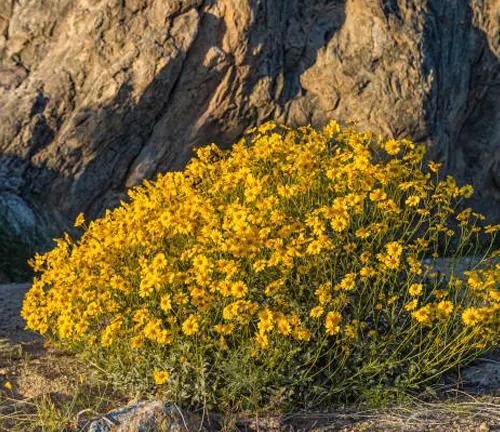
- Sunlight Requirements: Best in full sun.
- Watering Needs: Highly drought-tolerant; infrequent watering is preferred.
- Soil Type: Requires well-drained soils, performs poorly in wet soils.
- Temperature Tolerance: Tolerates high temperatures and moderate cold.
- Landscape Uses: Works well in mixed shrub borders, rock gardens, or as a color contrast in green spaces.
13. Beargrass (Nolina microcarpa)
Beargrass is not true grass but rather a perennial with a grass-like appearance. It forms dense clumps of long, narrow leaves that can add texture to any desert landscape. It is highly drought-resistant and adapts well to rocky soils.
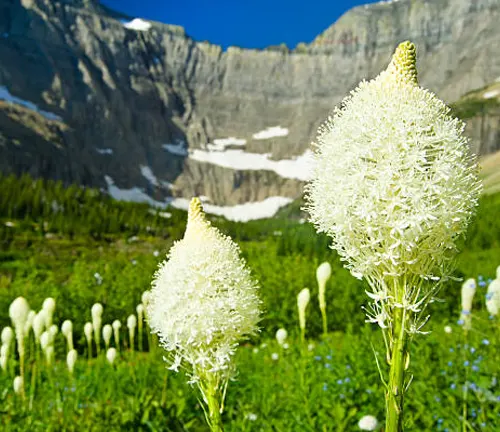
- Sunlight Requirements: Prefers full sun but can tolerate partial shade.
- Watering Needs: Extremely drought-tolerant; occasional deep watering during very dry periods.
- Soil Type: Thrives in rocky, well-drained soils.
- Temperature Tolerance: Resistant to both high heat and moderate cold.
- Landscape Uses: Ideal for adding texture and form to rock gardens or used as a ground cover in larger desert landscapes.
14. Soap Tree Yucca (Yucca elata)
The Soap Tree Yucca is a tall, slender plant with a crown of narrow, pale green leaves and a characteristic spire of white, bell-shaped flowers that bloom in late spring to early summer. The plant gets its name from the soapy material in its roots and trunk, historically used by Native Americans.
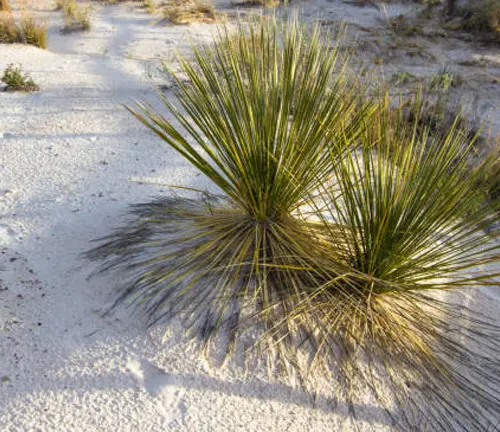
- Sunlight Requirements: Needs full sun to thrive.
- Watering Needs: Very low; water sparingly to mimic natural desert conditions.
- Soil Type: Prefers sandy, well-drained soil.
- Temperature Tolerance: Can handle extreme heat and light frosts.
- Landscape Uses: Works well as a vertical accent in dry garden settings or amidst rocks in natural desert landscapes.
15. Golden Barrel Cactus (Echinocactus grusonii)
The Golden Barrel Cactus is a popular choice for desert gardens, instantly recognizable by its rounded, barrel-shaped form and ribbed surface covered in golden-yellow spines. This cactus grows slowly but can eventually reach impressive sizes, making it a striking addition to any garden.
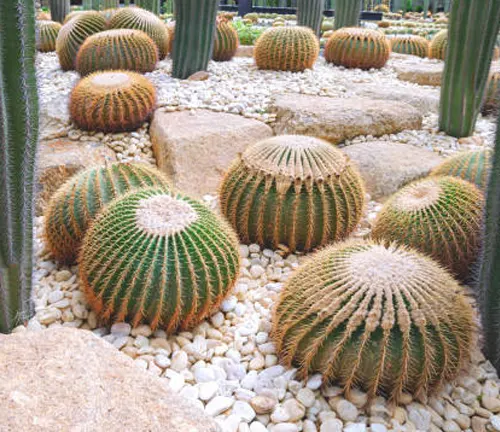
- Sunlight Requirements: Best in full sun.
- Watering Needs: Minimal; too much water can lead to rot.
- Soil Type: Must be very well-drained, preferably sandy or gravelly.
- Temperature Tolerance: Prefers warmth but can tolerate mild cold with protection.
- Landscape Uses: Ideal as a standalone feature or grouped with other cacti and succulents for a dramatic effect.
Planting and Maintenance Tips for Desert Landscapes
Planting Techniques
- Right Time to Plant: The best time to plant desert species is during the cooler months of autumn or early spring. This allows the plants to establish roots before the intense heat of summer.
- Soil Preparation: Enhance drainage by amending the soil with sand or gravel if necessary, especially for cacti and succulents that require well-drained conditions.
- Spacing: Provide sufficient space between plants to allow for air circulation and growth. This prevents disease and reduces competition for nutrients and water.
Maintenance Tips
- Watering Strategy: Water deeply but infrequently to encourage deep root growth, which helps plants withstand drought. Use drip irrigation to minimize water loss and deliver water directly to the root zone.
- Mulching: Apply a thin layer of gravel or rock as mulch to reduce water evaporation from the soil and help keep plant roots cool.
- Pruning: Minimal pruning is needed. Remove dead or damaged branches in the late winter or early spring to keep plants healthy and well-shaped.
Challenges and Considerations
- Pest Management: Keep an eye out for pests common to desert plants, such as spider mites and scale insects. Use environmentally friendly pest control methods to manage infestations.
- Disease Prevention: Avoid overwatering and ensure good soil drainage to prevent root rot and fungal diseases, which are common issues in poorly drained soils.
- Environmental Impact: Consider the local ecosystem when selecting plants. Native plants are preferable as they provide habitat and food for local wildlife and require fewer resources to maintain.
Related Post
- How to Build a Barn: A Step-by-Step Guide for Beginners
- How to Build a Sustainable Compost Bin: Easy and Eco-Friendly DIY
- How to Fertilize Bougainvillea: A Complete Guide for Stunning Blooms
- How to Fertilize Apple Trees: Essential Tips for a Bountiful Harvest
- How to Fertilize Lemon Trees: Secrets for Thriving Citrus
- How to Fertilize Avocado Tree: A Step-by-Step Guide for Lush Growth
- 10 Best Bow Saws to Buy in 2025: Top Picks for the Money
- Best Miter Saw For Beginners
- Top 10 Pruning Saws to Buy in 2025: Best for the Money
- 7 Best Pocket Chainsaw
Conclusion
Choosing desert plants for your landscaping is a powerful way to promote sustainability and resilience. These plants thrive in harsh conditions, adding beauty and life to difficult environments. By incorporating these hardy species into your garden, you help conserve water and support local biodiversity. Let these plants inspire your gardening journey as you create a space that is both stunning and sustainable.
FAQs
- What makes a plant well-suited for desert landscaping?
Plants suitable for desert landscaping have adaptations like thick, waxy leaves or deep root systems that allow them to conserve water and thrive in hot, dry environments. - Can desert plants survive in non-desert climates?
Many desert plants can adapt to non-desert climates if they receive sufficient sunlight and are planted in well-draining soil to prevent root rot, which is common in wetter conditions. - How often should I water desert plants in my garden?
Desert plants generally need minimal watering. It’s best to water them deeply but infrequently, allowing the soil to dry out completely between watering sessions to mimic their natural arid habitat. - Are there desert plants that can provide shade in my garden?
Yes, some larger desert plants like the Joshua Tree and Palo Verde can provide light, dappled shade with their spread-out branches and leaves, making them excellent choices for creating shaded areas in gardens. - What are some common pests that affect desert plants, and how can I manage them?
Common pests include spider mites and scale insects. Managing them involves regular monitoring and using non-toxic pest control methods, such as insecticidal soaps or neem oil. - Do desert plants attract wildlife?
Yes, many desert plants, especially those that flower, attract wildlife such as bees, butterflies, and hummingbirds, contributing to local biodiversity. - How can I use desert plants to create a low-maintenance garden?
By selecting a variety of desert plants that naturally thrive in your local climate, you can create a garden that requires little upkeep beyond occasional pruning and infrequent watering. - What are the best desert plants for adding color to a landscape?
Plants like the Prickly Pear Cactus, with its colorful blooms and fruit, and the Red Yucca, known for its long-lasting pink or red flowers, are excellent for adding vibrant color to a desert landscape.
We hope this guide to the top 15 desert plants for 2025 inspires you to explore the unique beauty and resilience of these species. Whether you’re a seasoned gardener or just starting out, incorporating these plants into your landscape can transform your outdoor space into a vibrant and sustainable oasis.

Kristine Moore
Forestry AuthorI'm Kristine Moore, a seasoned garden landscaping professional with over 30 years of experience. My extensive career has been dedicated to transforming outdoor spaces into stunning, sustainable landscapes. With a deep understanding of horticulture, design principles, and environmental stewardship, I have become a respected figure in the field, known for creating harmonious, visually appealing, and eco-friendly gardens. My commitment to excellence and continuous learning in landscaping trends and techniques has solidified my reputation as an expert in garden design and implementation.













Leave your comment